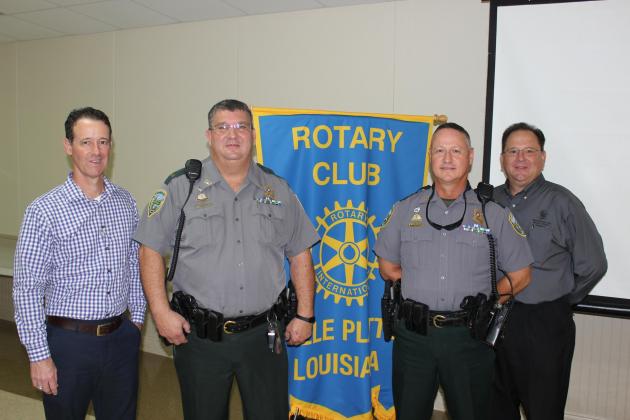During this week’s meeting of the Ville Platte Rotary Club, President Richard LeJeune announced that he will be stepping down from the position. He cited as reasons for his decision, his “lack of attendance and given the fact that I’ve taken over some new roles within my company.”
He went on to say that he will continue to be an active member in the club and that Vice President and former President Peter Strawitz will assume the responsibilities.
For LeJeune’s final meeting as president, the club heard from Sergeant Steve Vidrine and Lieutenant Scott Fontenot with the Louisiana Department of Wildlife and Fisheries. Both game wardens have recently been appointed to their respective positions, and Lieutenant Fontenot has also been named the district supervisor. The district encompasses six parishes including Evangeline and Allen.
Sergeant Vidrine used Tuesday’s meeting as an opportunity to talk about new regulations concerning deer and hog hunting.
He advised the Rotary Club there is a mistake on this year’s deer tags. “On it this year, the state put either sex deer tag cards at the bottom of the doe side,” he said. “Usually, that’s on the buck side. This year, it is allowed to tear it apart. Normally, you don’t tear them apart and attach them to the deer. This year, though, you will be able to because of that situation.”
Another change in deer hunting, according to Sergeant Vidrine, is that hunters now have 72-hours to call in their kills instead of seven days.
As far as hogs, Sergeant Vidrine said, “We get a lot of calls in the nighttime about the hog situation. It opens March 1 and closes August 31. We have a lot of people going out night hunting who are still using the excuse that they’re just hunting hogs, hog season is closed now. Farmers are the only ones, I think, who can get a permit to hunt hogs at night, but they have to have that permit with them at all times.”
Lieutenant Fontenot then stated, “Our primary goal is public safety. That’s our first and foremost goal; however, we are there to protect the fish, game, wildlife, and natural resources of this state.”
Because of that primary goal, he added, “We probably come across more narcotics than most agencies do out in the field especially in the last five to 10 years with methamphetamine being so prominent here in this parish and every parish that we work.”
LDWF also, according to Lieutenant Fontenot, is also responsible for litter control. “We are working with Solid Waste and the Evangeline Parish Police Jury,” he said. “We have some fundings that have come in for some surveillance equipment that we are going to be utilizing in the parish as well as other parishes for gross littering sites and for some other wildlife violations.”
He continued, “Vermilion Parish had given some money to its agents. They utilized the camera system and set it up pretty well where it was camouflaged. They made 35 or 40 cases in a matter of six months. We brought it here for three weeks. I think we ended up writing 11 or 12 citations at one bridge site here in the parish.”
One problem with the cameras, according to Lieutenant Vidrine, is “we ended up getting a couple cameras stolen. The camera that we had left didn’t catch enough information. We thought we had the violator, but we couldn’t prove it.”
At last week’s meeting, the Rotary Club heard from Jennifer Martin who is the director of development of Shriners Hospital in Shreveport. She stated the Shreveport hospital was built in 1922 as the first location. She also said, since then, the hospital has expanded to 22 locations.
“We are still located on the same exact site today which is actually right off I-49 and King’s Highway, so we couldn’t have planned it to be any easier to tell people how to get to us,” explained Martin.
Shriner’s Hospital in Shreveport, as Martin said, treats mainly cerebral palsy, scoliosis, cleft lip and pallet, spine pathology, and fractures. The hospital also treats children from six states and the Republic of Panama. She commented, “We have a lot of Panamanian children who come to us for three to four weeks at a time because it’s just too expensive to send them home after a clinic or rehab visit. So, you’ll see a lot of people who speak Spanish in our hospital on any given day because we have those children in house.”
Martin then explained one of the “cool things” that the Shreveport hospital offers. She said, “Our hospital has a motion analysis lab. Electrodes tell which way the child’s leg gives when they walk and how their foot lays so they can help the surgeon figure out what is the best course of treatment. It creates a wonderful visual and measures foot positions like Dr. Scholl’s at Wal Mart, and it can tell what part of the foot the child is putting down.”
One new piece of equipment at the hospital, according to Martin, is the EOS imaging machine. “This machine provides 85 percent less radiation,” she stated. “In 2016, we started raising money for this machine that cost about $860 thousand including the renovation to the hospital. The EOS machine is physically in the building and on stage in the auditorium at the moment while we renovate to put this machine in. We hope to have it running by December 1.”
Image
TONY MARKS Associate Editor

